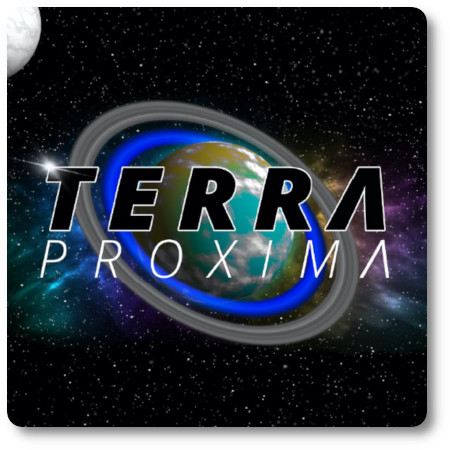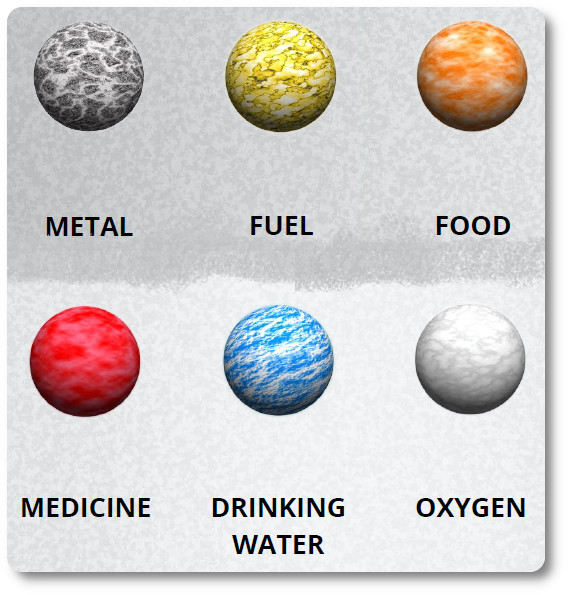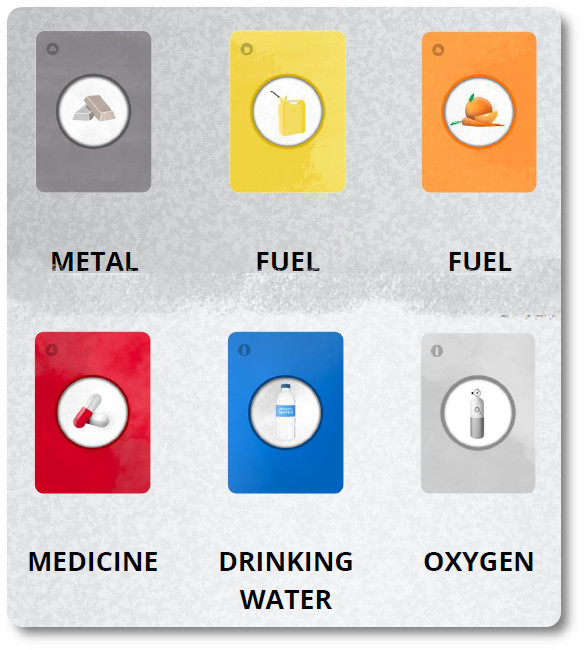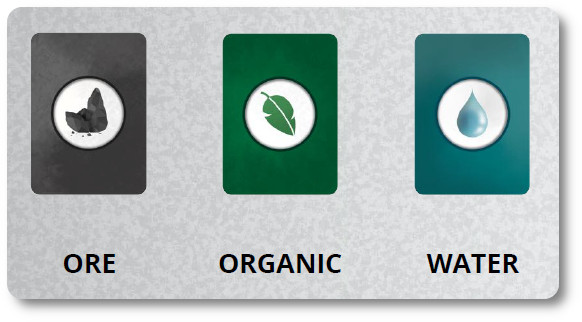Please Take Note: This is a review of the final game, but it might change slightly based on the Kickstarter campaign’s success. The game is being reviewed on the components and the rules provided with the understanding that “what you see is not what you might get” when the game is published. If you like what you read and want to learn more, we encourage you to visit the game’s website or visit the Kickstarter campaign. Now that we have all that disclaimer junk out of the way, on with the review.

The Basics:
- For ages 10 and up
- For 3 to 6 players
- Approximately 120 minutes to complete
Geek Skills:
- Active Listening & Communication
- Counting & Math
- Logical & Critical Decision Making
- Strategy & Tactics
- Risk vs. Reward
- Hand/Resource Management
- Trading
Learning Curve:
- Child – Easy
- Adult – Easy
Theme & Narrative:
- Race to find the planet Terra Proxima at the center of the galaxy!
Endorsements:
- Gamer Geek approved!
- Parent Geek approved!
- Child Geek approved!
Overview
English theoretical physicist, cosmologist, and author who was director of research at the Centre for Theoretical Cosmology at the University of Cambridge, Stephen Hawking said: “I think the human race doesn’t have a future if it doesn’t go into space.” In this game, players are humanity’s greatest hope of finding new resources and homes for the expanding human race. Each player takes on the role of leading ships deeper into the void to find the fabled planet Terra Proxima. The first to plant their flag will win the game, but the race to the center of the galaxy is anything but easy or safe.
Terra Proxima, to be published by Bavarian Games, will reportedly be comprised of one game board, six Long Range Cruisers, 12 Scout Ships, six Bases, 60 Lunar Material cards, 108 Planetary Material cards, six Defense cards, six Plus One cards, six System Repair cards, 12 Electromagnetic Pulse (EMP) tokens, 42 Research tokens, and two dice. As this is a review of a prepublished game, I cannot comment on the game component quality.
A quick note to you, dear reader: We were not provided a physical copy of this game for review. Instead, we could play and share the game with our friends and family using the application Tabletopia. The experience our players had with the game should not be considered the “norm” due to the learning curve we had with some of our groups with the application itself, let alone learning the game. Board, card, and dice games are played best if you physically manipulate them. However, in a time of a pandemic outbreak and our dedication to keeping our loved ones safe, we were happy to experience Terra Proxima using this method. Saying all that, this was a weird review to write. Enjoy!
Prepping for Space
To set up the game, first sort the nine stacks of Material Cards by type into nine stacks, placing them near the board to create the “Salvage Yard.”
Second, shuffle and place the EMP, Research, Plus One, System Repair, and Defense cards and tokens into neat piles near the gameboard and within easy reach of at least one player.
Third, give each player one Long Range Cruiser (LRC), two Scout Ships, and one Base in the color of their choice. Also, give each player one of each the Planetary Material cards, one Plus One card, and one Defense card.
Fourth, determine how will be the first player using whatever method the group decides. The first player chooses a starting Launch Pad by placing their LRC on that space on the gameboard. The remaining players now do the same on their respective Launch Pad space in clockwise order as follows:
- In a three-player game, place each player on every other Launch Pad.
- In a four-player game, place the second player on the next Launch Pad, and place the third and
fourth opposite the first and second, respectively. - In a five or six-player game, place each player on the next available Launch Pad.
Fifth, deal with each player one System Repair card.
That’s it for game setup. Let the great space race begin!
Exploring the Void
Terra Proxima is played in turns with no set number of turns per game. A player’s turn is summarized here, but each player’s first turn does not include the Production phase, their first action must be a Move, and Wormholes on the gameboard cannot be used. After the player’s first turn, they follow a simple two-phase turn resolution process.
Phase One: Production
During this phase, the player will take the dice and roll them. Each die is a single result, and for every die, every player in the game receives one Material card for each ship or base on a Planet or a Moon space containing the number shown on the die. If you know the game Settlers of Catan, this will feel very familiar to you.

If doubles are rolled, an EMP attempt has been made and must be immediately resolved. This is good news for the active player and a bit of a nail-biter for everyone else.
If the active player has two or fewer EMP tokens in their possession, the EMP attempt fails, resulting in the following:
- The active player returns all of their EMP tokens to the Salvage Yard
- The active player must forfeit two Planetary Material cards of their choice to the Salvage Yard
- All other players collect Material cards, but not the active player who is free to sulk in the corner
However, if the player now has three or more EMP tokens, the EMP attempt succeeds, resulting in the following:
- The active player is given one EMP token
- The active player is the only player to collect Material cards (“ha-ha,” giggles the active player)
- The active player may take one Planetary Material card from any other player or two Lunar Material cards from any other layer or take one Lunar Material card from two different players
Phase Two: Action
After collecting materials and resolving any EMP shenanigans, it’s time for the player to actually do something with all those cards in their hand.
A player’s hand will consist of a mix of cards. Each is summarized here:
Material Cards
Material cards come in two types. These are Lunar and Planetary. Planetary Material cards are kept secret in the player’s hand, while Lunar Material cards are always displayed face-up to the table. These two types of cards, be they in the player’s hand or on the table, are considered in the player’s hand.
Planetary Material cards provide to the player metal, fuel, medicine, drinking water, and oxygen.

Lunar Material cards will provide ore, organic material, and water (that you cannot drink because Moon water is yucky).

Lunar Material Cards and Planetary Material Cards give a player’s hand “weight,” and each player’s hand has a “weight limit.” For each type of Material Card (be it Lunar or Planetary), players may only have eight each for a maximum of sixteen cards. At no time can a player have more than eight cards of either Material Card type for any reason. Players cannot have more than eight of either Material Card type in their hand for any reason.
System Repair Cards
These cards are given to the player early, and list required the repairs needed before a player can successfully land on Terra Proxima. Completing a repair is done by making a single “payment” of four Planetary Material cards listed to the Salvage Yard. Once the repairs are completed, the player discards their System Repair card to the Salvage Yard and is free to land on Terra Proxima… if they can find it.
Defense Cards
These cards are also given to the player early in the game and can be used once to give the player a bonus in combat. When used, the player earns a “+3” bonus to their die roll when they determine their Defense value. Once used, the Defense card is discarded to the Salvage Yard.
Plus One Card
These cards, just like System Repair and Defense cards, are given to the player early. They can be used once to give the player any one Planetary Material card of their choice from the Salvage Yard. Once used, the Plus One card is discarded to the Salvage Yard.
There are four actions the player can take, which can be resolved in any order the player likes, with the exception of the player’s first turn (which only allows the Move action). Players must first “pay” for the action they want to resolve before attempting it.
Move Action
This action allows the player to move their ships on the game board. To pay for the movement, the player must discard one Planetary Material card, two matching Lunar Material cards, or one of each Lunar Material card type. If the player can pay for the movement, the player can now move all their ships (even those that are built later in the player’s turn) up to three spaces on the game board. Paying for additional moves only allows the player to move one ship of the player’s choice but allows them to utilize available Wormholes that act as teleporters.
There are obstacles in space, such as Asteroid Belts and Nebulas. There is also the question of the complex navigational maneuvering needed to land safely on Terra Proxima. To bypass obstacles and make tricky navigational actions, the player must have the needed number of Research tokens.

Cards and tokens used as payment are returned to the Salvage Yard.
Trade Action
This action allows the player to trade Material cards with an opponent freely or directly with the Salvage Yard. A player can also discard (referred to as “jettisoning”) any Material cards in their hand to the Salvage Yard at this time. Depending on who the player trades with, there are a few restrictions.
If trading with a player:
- Both players must make sure that the trade does not put them over their weight limit
- Only cards may be traded (you cannot trade cards for favors or promises of actions in the future)
- Each trade per card must be completed before a new trade is discussed
If trading with the Salvage Yard:
- Trade two ore for one metal or fuel
- Trade two organic materials for one food or one medicine
- Trade two water for on drinking water or one oxygen
- Trade three matching Planetary Material cards for any other single Planetary Material card
Build Action
This action allows the player to build a base, a scout ship, or a Research token. Only one of the following can be built per player’s turn. Once built, they go to either the Outer board area or the Middle board area (never to the Inner board area), and no more than two pieces can occupy the same Planet or Moon at the same time.
- Players receive one Base for free during the game, costing them nothing to build it. Bases give players additional opportunities to collect Material cards. Players do not need to build their Base right away, but it must be placed on a Planet or Moon space that contains one or more of their ships when they do. Once the base is built, it remains in that location for the duration of the game.
- Players receive two Scout ships per game. The player must pay to the Salvage Yard one metal or fuel, one food or medicine, and one drinking water or oxygen Material cards to build them. Once paid for, the Scout ship is placed on any Planet or Moon occupied by a player’s ship. Scouts ships are great for exploration in open space but cannot move or attack through Asteroid Belts or Nebulas.
- Players must earn their Research tokens. To do so, they pay one of each of the Planetary Material cards to the Salvage Yard. Research tokens give the player the following abilities:
- One Research token allows the player’s ships to move through Asteroid Belts
- Three Research tokens allow the player’s ships to move through Nebulas
- Seven Research tokens allow the player’s ships to land on Terra Proxima (if they have completed their System Repair)
- Having more Research tokens than an attacking opponent provides a Defense bonus
Attack Action
Make no mistake. Terra Proxima is a race, and there can be only one winner. How a player wins is up to them, and it is perfectly acceptable to hinder an opponent by taking out their ships or base on your journey to the finish line.
If a player has a ship fewer than three spaces away from an opponent’s ship or base, and they have at least one Planetary Material card or two matching Lunar Material cards, they can engage their opponent in combat. Combat is resolved as follows, and only one attack action can be taken per turn:
- The attacker declares combat and identifies their target
- Each player in combat rolls one die, with the attacker rolling first and adding any support bonuses
- The defender then rolls their die, adding any Research token and Defense card bonuses
- The player with the higher total value wins
Support can be given to the attacker by any single player who is not engaged in the attack action. This is done by the supporting opponent placing one Planetary Material card or two matching Lunar Material cards as a wager. Supporting the attacker gives the attacker a “+1” bonus to their roll.
If the defender has more Research tokens than the attacker, the defender adds a “+1” bonus to their roll for each additional Research token they have in greater numbers for a maximum of “+2” bonus. The defender can also play their one-and-done Defense card, which gives a “+3” bonus to the die roll.
Depending on who wins, the following is then resolved:
A successful attack (attacker wins):
- Attacker receives two Planetary Material cards or four Lunar Material cards from the Planet or Moon that the defending player was on (taken from the Salvage Yard)
- Defender discards to the Salvage Yard any one Planetary Material card or two matching Lunar Material cards from their hand
- If the target of the attack was a ship and the defender does not have any ships currently in empty space, the defender now moves their ship to any unoccupied adjacent empty space of their choice
- If an opponent supported the attacker, the supporting opponent receives one Planetary Material card or two matching Lunar Material cards of their choice from the Salvage Yard, along with their wager.
- The attacker may pay for one additional Move action for any one of their ships.
An unsuccessful attack (defender wins):
- The attacker must forfeit one Planetary Material card or two matching Lunar Material cards of their choice to the Salvage Yard.
- The attacking ship cannot be moved for the duration of the player’s turn.
- If an opponent supported the attacker, the supporting opponent’s wager is placed in the Salvage Yard.
- If the Defense card was used, the defender receives one PLanetary Material card or two matching Lunar Material cards of their choice from the Salvage Yard.
If combat ends in a tie:
- The attacker, defender, and supporting opponent neither forfeit nor receive any Material cards.
- The supporting opponent’s wager is returned to the player.
- The attacking ship may move as normal.
Finding Terra Proxima
The game comes to an end when any player earns seven Research tokens, resolves their System Repair, and moves onto the Terra Proxima space on the game board. The first individual to do so wins the game!
Game Variants
If a semi-cooperative game is more to your liking, you can play Terra Proxima in teams (referred to as “Allies”). Setup is different, but the gameplay remains largely the same, with subtle differences in the various phases and actions. Players help each other and can freely discuss strategies and tactics within their allied group. Victory is given to the first allied group when all of their party members earn the needed seven Research tokens, resolve their System Repair, and move onto the Terra Proxima space on the game board.
To learn more about Terra Proxima, visit the game’s website or visit the Kickstarter campaign.
Final Word
 The Child Geeks had a great time with the game, easily understanding how the game was played and how they needed to play to win. The games were a bit too long for our youngest Child Geeks, and since the games could not be “parked,” there were a few games we could not finish. It turns out that didn’t stop the Child Geeks from enjoying their space journey. According to one Child Geek, “I liked the game. It was easy to learn and fun to play as the commander of a big space group.” Another Child Geek said, “It can be frustrating not to get the cards you need, but all you have to do is keep exploring and you’ll find what you need.” When the Terra Proxima was finally found, all the Child Geeks agreed it was worth the journey.
The Child Geeks had a great time with the game, easily understanding how the game was played and how they needed to play to win. The games were a bit too long for our youngest Child Geeks, and since the games could not be “parked,” there were a few games we could not finish. It turns out that didn’t stop the Child Geeks from enjoying their space journey. According to one Child Geek, “I liked the game. It was easy to learn and fun to play as the commander of a big space group.” Another Child Geek said, “It can be frustrating not to get the cards you need, but all you have to do is keep exploring and you’ll find what you need.” When the Terra Proxima was finally found, all the Child Geeks agreed it was worth the journey.
 The Parent Geeks also had a great time, enjoying the challenge of managing their resources and finding new ones as they explored the galaxy. According to one Parent Geek, “I liked it. Played very casually, turns were easy to manage, and the game felt like it was progressing nicely. I enjoyed myself a good deal.” Another Parent Geek said, “A good mix of hand management, resource management, and exploration. Combat is a bit silly, but it was still fun to take the occasional potshot at a passing ship.” When the last ship reached its base, the Parent Geeks took count and found Terra Proxima pleased them all.
The Parent Geeks also had a great time, enjoying the challenge of managing their resources and finding new ones as they explored the galaxy. According to one Parent Geek, “I liked it. Played very casually, turns were easy to manage, and the game felt like it was progressing nicely. I enjoyed myself a good deal.” Another Parent Geek said, “A good mix of hand management, resource management, and exploration. Combat is a bit silly, but it was still fun to take the occasional potshot at a passing ship.” When the last ship reached its base, the Parent Geeks took count and found Terra Proxima pleased them all.
 The Gamer Geeks were also pleased, finding the game to be casual but strategic, with tactical choices to be made and the game’s depth allowing for interesting choices and problems to solve. According to one Gamer Geek, “This game is all about managing your resources, and I found it to be a fun twist that some of what I had was visible to my opponents. This made it tricky at times to decide which of my resources to spend and gave me a lot of information on which opponent I should trade with.” Another Gamer Geek said, “A solid game. Very casual but engaging. The game’s length feels a bit long, but I think that has more to do with the fact we played it on the computer. Pretty sure a real game with real people and real game components would go faster and would be even more fun.” When the last planet was colonized and the final moon explored, the Gamer Geeks gave Terra Proxima their full approval.
The Gamer Geeks were also pleased, finding the game to be casual but strategic, with tactical choices to be made and the game’s depth allowing for interesting choices and problems to solve. According to one Gamer Geek, “This game is all about managing your resources, and I found it to be a fun twist that some of what I had was visible to my opponents. This made it tricky at times to decide which of my resources to spend and gave me a lot of information on which opponent I should trade with.” Another Gamer Geek said, “A solid game. Very casual but engaging. The game’s length feels a bit long, but I think that has more to do with the fact we played it on the computer. Pretty sure a real game with real people and real game components would go faster and would be even more fun.” When the last planet was colonized and the final moon explored, the Gamer Geeks gave Terra Proxima their full approval.
 This is a fun game. It reminded me a good deal of Settlers of Catan – to a point – and left me with the impression that the design is close to a very light 4X game (wherein the 4 “x’s” mean Explore, Expand, Exploit, and Exterminate). Except, what you are really doing is Exploring, Expanding, Engaging, and … what’s an “E” word for trading … Exchanging. A slightly different take, and it worked very well.
This is a fun game. It reminded me a good deal of Settlers of Catan – to a point – and left me with the impression that the design is close to a very light 4X game (wherein the 4 “x’s” mean Explore, Expand, Exploit, and Exterminate). Except, what you are really doing is Exploring, Expanding, Engaging, and … what’s an “E” word for trading … Exchanging. A slightly different take, and it worked very well.
This was a different experience for all my groups. We are used to playing physical board games with each other, engaging players over the table, and moving bits and pieces between us as the game unfolds. Not the case here, as we all shared the same experience over the computer. I have been playing board, card, and dice games over the computer for years and had no issue. Lots of groups have never done so before and found it to be either complicated to get involved or a brand new way to enjoy their hobby with friends and family no matter where they lived. Terra Proxima was a great introduction, allowing players to play an engaging game over a fairly easy platform to master.
I very much enjoyed Terra Proxima and absolutely believe the game I played on the virtual gaming table will be all the more interesting when it finally arrives as a physical copy. Good stuff here and very streamlined. It was a joy to play and challenging to win. Do try this game when time allows and explore what it has to offer.
This is a paid-for review of the game’s final prototype. Although our time and focus were financially compensated, our words are our own. We’d need at least 10 million dollars before we started saying what other people wanted. Such is the statuesque and legendary integrity of Father Geek, which cannot be bought except by those who own their private islands and small countries.
Discover more from Father Geek
Subscribe to get the latest posts sent to your email.





